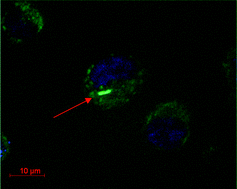Biocompatible dispersions of carbon nanotubes: a potential tool for intracellular transport of anticancer drugs†
Abstract
The use of the biocompatible amphiphilic

* Corresponding authors
a
Dipartimento di Scienze del Farmaco, Università “G. d'Annunzio”, Via dei Vestini, Chieti, Italy
E-mail:
fontana@unich.it
Fax: +39 0871 3554791
Tel: +39 0871 3554790
b Institute for Bioengineering and Institute for Chemical Sciences and Engineering, École Polytechnique Fédérale de Lausanne (EPFL), Station 15, Lausanne, Switzerland
The use of the biocompatible amphiphilic

 Please wait while we load your content...
Something went wrong. Try again?
Please wait while we load your content...
Something went wrong. Try again?
A. Di Crescenzo, D. Velluto, J. A. Hubbell and A. Fontana, Nanoscale, 2011, 3, 925 DOI: 10.1039/C0NR00444H
To request permission to reproduce material from this article, please go to the Copyright Clearance Center request page.
If you are an author contributing to an RSC publication, you do not need to request permission provided correct acknowledgement is given.
If you are the author of this article, you do not need to request permission to reproduce figures and diagrams provided correct acknowledgement is given. If you want to reproduce the whole article in a third-party publication (excluding your thesis/dissertation for which permission is not required) please go to the Copyright Clearance Center request page.
Read more about how to correctly acknowledge RSC content.
 Fetching data from CrossRef.
Fetching data from CrossRef.
This may take some time to load.
Loading related content
